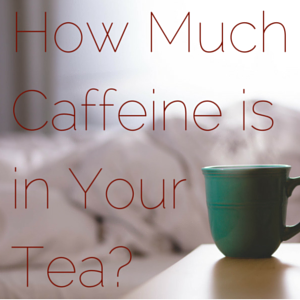
Practical Advice for Caffeine Lovers and Loathers
For those of our readers who are caffeine intolerant, we carry many a decaf tea and caffeine-free tea (which are, by the way, not quite the same thing). However, if you’re like me, you understand that tea, like all things, has a purpose, and that purpose is feeding a serious caffeine problem. Or, I don’t know, you might have a healthy relationship with caffeine. That works, too.
Two Ways You Get Caffeine From Tea
 Regardless, tea has caffeine. The amount of caffeine in your tea varies depending upon the region in which it is grown, the age of the leaf when it is plucked, the nutrients in the soil in which the tea plant is grown, the amount of rainfall the plant receives, and the plant’s mood (I’m joking about the last one, but the others are actually true). Regardless of how the tea plants are feeling, your cup of tea is generally going to have a concentration of caffeine somewhere in the neighborhood of a third of the strength of coffee.
Regardless, tea has caffeine. The amount of caffeine in your tea varies depending upon the region in which it is grown, the age of the leaf when it is plucked, the nutrients in the soil in which the tea plant is grown, the amount of rainfall the plant receives, and the plant’s mood (I’m joking about the last one, but the others are actually true). Regardless of how the tea plants are feeling, your cup of tea is generally going to have a concentration of caffeine somewhere in the neighborhood of a third of the strength of coffee.
 In general, leaves which are younger when they are picked have a higher caffeine content. Scientists believe that the plant may concentrate caffeine in young leaves as a means of keeping bugs away from them, as bugs, unlike people, do not like caffeine. This means that Silver Needles white tea has one of the highest caffeine concentrations in our store. This tea is the first pick of the growing season, and the leaves are plucked while they are young and still have the downy coating of winter on them.
In general, leaves which are younger when they are picked have a higher caffeine content. Scientists believe that the plant may concentrate caffeine in young leaves as a means of keeping bugs away from them, as bugs, unlike people, do not like caffeine. This means that Silver Needles white tea has one of the highest caffeine concentrations in our store. This tea is the first pick of the growing season, and the leaves are plucked while they are young and still have the downy coating of winter on them.
A shorter steeping time, or steeping tea at a lower temperature, will reduce the amount of caffeine in your cup. This means that, even though white, green, oolong and black tea leaves all contain about the same amount of caffeine, a cup of white or green tea will have less caffeine in it than a black or oolong, because green and white teas should be steeped at lower temperatures and for shorter times. If you steep a green tea like a black tea, it will have the same amount of caffeine as a black tea--it will just also be oversteeped and burned. Similarly, a weakly brewed black or oolong tea will have a caffeine content similar to that of a green or white tea.
 Tea leaves can be re-steeped, but each steep will contain less flavor, nutrients, and, yes, caffeine than the steep before it. This means that, for people with a lower caffeine tolerance, re-steeping your tea throughout the day can be a good strategy to both make your tea last longer, and get a better night’s sleep. Most teas will stand up to a second steep reasonably well, but if you want to brew the same teaspoon of leaves any more than that, we recommend a high-quality green tea such as Gyokuro. Our Jasmine Dragon Pearls can easily be brewed four or even five times.
Tea leaves can be re-steeped, but each steep will contain less flavor, nutrients, and, yes, caffeine than the steep before it. This means that, for people with a lower caffeine tolerance, re-steeping your tea throughout the day can be a good strategy to both make your tea last longer, and get a better night’s sleep. Most teas will stand up to a second steep reasonably well, but if you want to brew the same teaspoon of leaves any more than that, we recommend a high-quality green tea such as Gyokuro. Our Jasmine Dragon Pearls can easily be brewed four or even five times.
The caffeine content in a cup of tea can vary depending upon where the leaves are from, how the tea was brewed, how long and at what temperature it steeped for, and how many times it has been steeped before. There isn’t an exact science to how much caffeine is in your cup. How the same amount of caffeine affects you can also vary depending upon how you’ve been sleeping, what your blood sugar looks like, and how much strain you’re putting your body under. In the end, keeping yourself in that productive zone between lethargic and jittery or worse, headache, is much more an art than a science, and will require a little time and experimentation.
Sample our teas mentioned in this article here!
